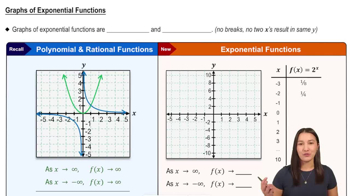Suppose the interval [1, 3] is partitioned into n = 4 subintervals. What is the subinterval length ∆𝓍? List the grid points x₀ , x₁ , x₂ , x₃ and x₄. Which points are used for the left, right, and midpoint Riemann sums?
Table of contents
- 0. Functions7h 54m
- Introduction to Functions16m
- Piecewise Functions10m
- Properties of Functions9m
- Common Functions1h 8m
- Transformations5m
- Combining Functions27m
- Exponent rules32m
- Exponential Functions28m
- Logarithmic Functions24m
- Properties of Logarithms36m
- Exponential & Logarithmic Equations35m
- Introduction to Trigonometric Functions38m
- Graphs of Trigonometric Functions44m
- Trigonometric Identities47m
- Inverse Trigonometric Functions48m
- 1. Limits and Continuity2h 2m
- 2. Intro to Derivatives1h 33m
- 3. Techniques of Differentiation3h 18m
- 4. Applications of Derivatives2h 38m
- 5. Graphical Applications of Derivatives6h 2m
- 6. Derivatives of Inverse, Exponential, & Logarithmic Functions2h 37m
- 7. Antiderivatives & Indefinite Integrals1h 26m
- 8. Definite Integrals4h 44m
- 9. Graphical Applications of Integrals2h 27m
- 10. Physics Applications of Integrals 3h 16m
- 11. Integrals of Inverse, Exponential, & Logarithmic Functions2h 34m
- 12. Techniques of Integration7h 41m
- 13. Intro to Differential Equations2h 55m
- 14. Sequences & Series5h 36m
- 15. Power Series2h 19m
- 16. Parametric Equations & Polar Coordinates7h 58m
8. Definite Integrals
Riemann Sums
Problem 5.1.53b
Textbook Question
{Use of Tech} Riemann sums for larger values of n Complete the following steps for the given function f and interval.
ƒ(𝓍) = x² ― 1 on [2,5] ; n = 75
(b) Based on the approximations found in part (a), estimate the area of the region bounded by the graph of f and the x-axis on the interval.
 Verified step by step guidance
Verified step by step guidance1
Step 1: Understand the problem. The goal is to estimate the area under the curve ƒ(𝓍) = x² ― 1 on the interval [2,5] using Riemann sums with n = 75 subintervals. This involves dividing the interval into 75 equal parts and summing the areas of rectangles formed under the curve.
Step 2: Calculate the width of each subinterval (Δx). The formula for Δx is Δx = (b - a) / n, where [a, b] is the interval and n is the number of subintervals. Here, a = 2, b = 5, and n = 75.
Step 3: Determine the x-values for the subintervals. These are the points where the function will be evaluated. For a left Riemann sum, the x-values are x₀, x₁, ..., xₙ₋₁, where xₖ = a + kΔx for k = 0, 1, ..., n-1. For a right Riemann sum, the x-values are x₁, x₂, ..., xₙ, where xₖ = a + kΔx for k = 1, 2, ..., n.
Step 4: Evaluate the function ƒ(𝓍) = x² ― 1 at each x-value. For each subinterval, calculate the height of the rectangle by substituting the x-value into the function ƒ(𝓍).
Step 5: Compute the Riemann sum. Multiply the height of each rectangle (ƒ(xₖ)) by the width of the subinterval (Δx), and sum these products over all subintervals. This sum will approximate the area under the curve on the interval [2,5].
 Verified video answer for a similar problem:
Verified video answer for a similar problem:This video solution was recommended by our tutors as helpful for the problem above
Video duration:
4mPlay a video:
Was this helpful?
Key Concepts
Here are the essential concepts you must grasp in order to answer the question correctly.
Riemann Sums
Riemann sums are a method for approximating the definite integral of a function over an interval. By dividing the interval into 'n' subintervals and calculating the sum of the areas of rectangles formed by the function's values at specific points (left, right, or midpoints), we can estimate the total area under the curve. As 'n' increases, the approximation becomes more accurate, converging to the actual integral.
Recommended video:

Introduction to Riemann Sums
Definite Integral
The definite integral of a function over an interval represents the exact area under the curve of the function between two points. It is denoted as ∫[a,b] f(x) dx, where 'a' and 'b' are the limits of integration. The definite integral can be computed using various techniques, including Riemann sums, and is fundamental in calculus for determining total accumulation, such as area, volume, and displacement.
Recommended video:

Definition of the Definite Integral
Function Behavior
Understanding the behavior of the function f(x) = x² - 1 is crucial for estimating the area under its curve. This quadratic function opens upwards and intersects the x-axis at x = -1 and x = 1, meaning it is positive on the interval [2, 5]. Analyzing the function's values within the specified interval helps in determining the area bounded by the graph and the x-axis, which is essential for accurate Riemann sum calculations.
Recommended video:

Graphs of Exponential Functions
Related Videos
Related Practice
Textbook Question
17
views


